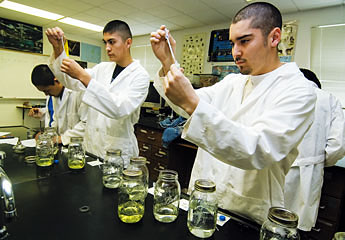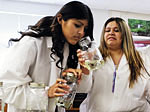|
Students test Gallup gas
Experiment determines water content

Chris Saucedo, right, and Josh Halona fill vials with gasoline Thursday
at Central High School in Gallup as they prepare test samples for
an experiment to see how much water is in the gasoline that they
purchased from area service stations. [Photo by Jeffery Jones/Independent
By Bill Donovan
Staff Writer

Latisha Bowman smells a container of gasoline held by her lab
partner, Perlita Arteaga during a science experiment Thursday
at Central High School in Gallup. [Photo by Jeffery Jones/Independent] |
GALLUP — Chris Saucedo has a 1987 Chevy which
he admits is a gas hog.
So, while doing a discussion on energy usage in his class at Central
High School, Saucedo convinced his teacher, John Spaulding, to make
it a class project to do some experiments to determine which gasolines
sold in town provided best gas mileage.
It took several days, with classmates going around to gas stations
along and near U.S. Highway 66 to get gasoline to use for testing
purposes.
A couple of stations refused to sell them gasoline, Saucedo said,
mainly because they were only asking to buy 10 cents worth. But
12 stations did allow the sales, which gave Saucedo and his other
classmates enough to do several tests.
"The object of the tests," said Saucedo, "was to
determine the water content of the gasoline we bought."
The idea was that the more water in the sample, the less gasoline
and therefore less miles per gallon.
Having water in the tank could be an indication, he said, that the
tank at the station was allowing water to seep in. "We also
wanted to determine if any gas stations were ripping us off,"
he said.
After two days of tests, there were two clear winners, he said.
The gas samples from Nechero's Shell and Nechero's Chevron test
better than any of the other samples.
The other stations tested included Thriftway, Eagle, Allsup, Mustang,
Gas & Save, Gas-Up, Texaco, Conoco and Luv's Truck Stop.
The class did a calorie test the higher the calorie the more fuel
in the product. It also did a centrifuge test, to separate gasoline
from water and a test using methylene blue, which, as it names implies,
turns any water or alcohol in the product blue while leaving the
gasoline clear.
The calorie tests showed stations receiving scores of anyway from
73 to 345, but Spaulding said at the level of the testing done by
the students, the results were probably not the most accurate.
"There is a high variance," he said. "the scores
could be 100 points off."
But Saucedo was satisfied with his results, saying that there was
no doubt in his mind which gasoline stations he would be using in
the future, even though the prices at Nechero's stations are higher
than at some of the other stations that were tested.
"You get what you pay for," said Bill Nechero, who, with
his brother Frank, operates the two top stations in the student's
testing.
While some of the non-brands sell for 10 to 15 cents a gallon less,
none have the additives that the major brands put in their gasolines
and these additives makes the fuel burn faster and more efficiently,
providing more miles to the gallon.
"With additives, you get better mileage and cleaner engines,"
he said.
|
Monday
February 5, 2007
Selected
Stories:
Minimum
wage increase is no longer local issue
New Kayenta
clothing store opens
Grants
man faces multiple felony charges
Students
test Gallup gas; Experiment determines water content
Deaths
|



